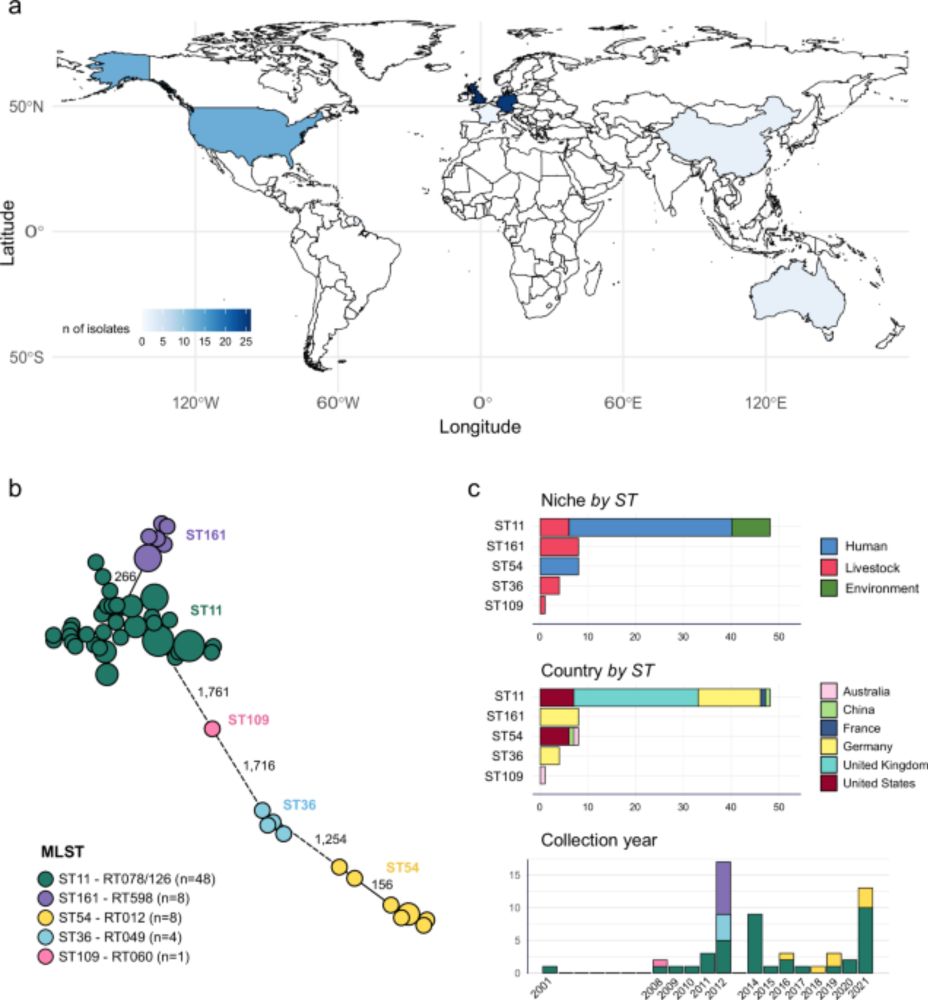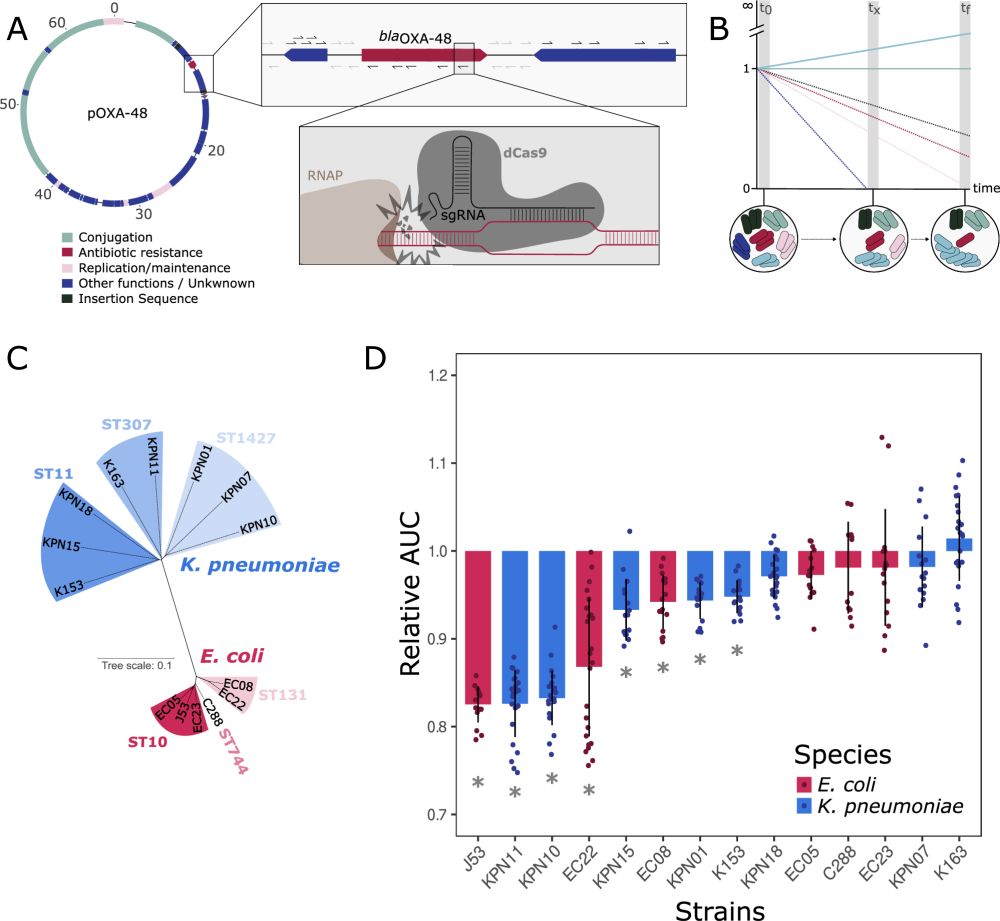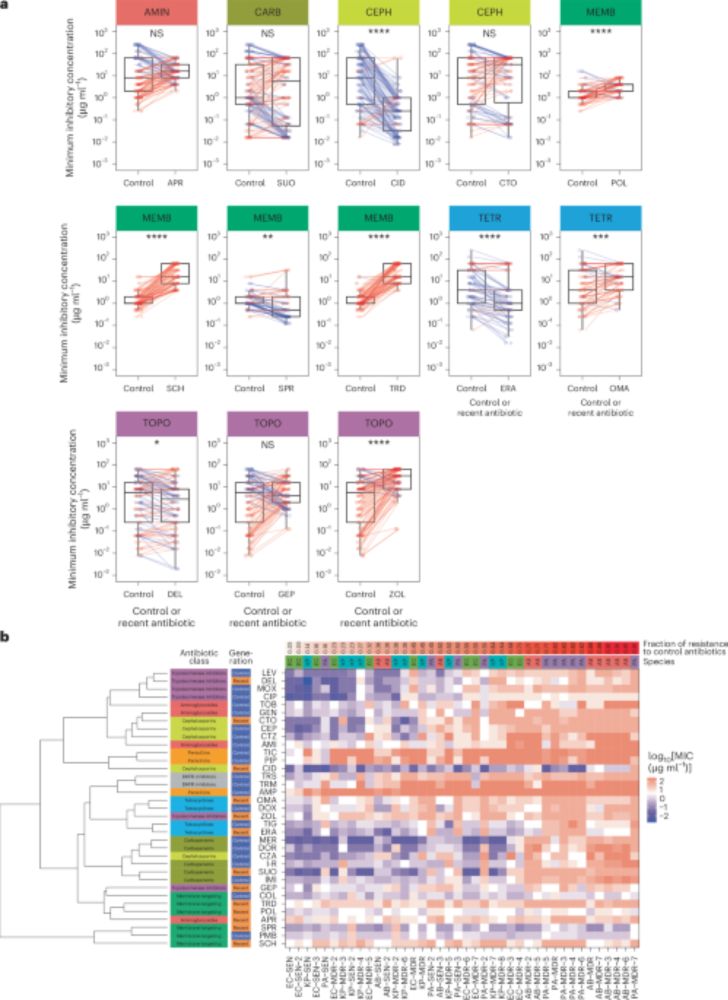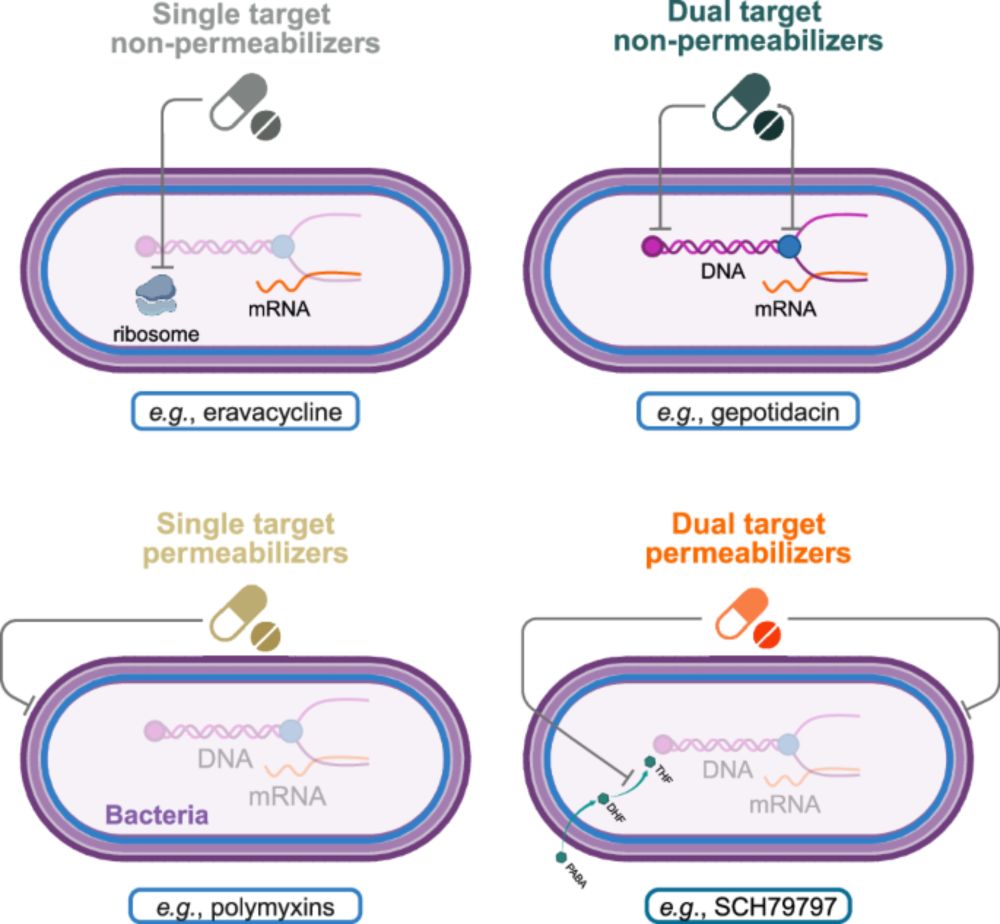
Ricardo Leon-Sampedro
@rleonsampedro.bsky.social
| Plasmids, Evolution and Antibiotic Resistance.
| Postdoctoral researcher at ETH Zurich.
| Microbiology & Bioinformatics.
| Postdoctoral researcher at ETH Zurich.
| Microbiology & Bioinformatics.
Pinned

Multi-layered ecological interactions determine growth of clinical antibiotic-resistant strains within human microbiomes
Nature Communications - The role of ecological factors in modulating the spread of antibiotic-resistance bacteria in the gut remains unclear. Here, the authors use anaerobic microcosms to study the...
rdcu.be
🚨 Excited to share our new paper is out! 🎉
We show how interactions within gut microbiomes allow certain antibiotic-resistant E. coli strains to persist even without antibiotics, helping explain how resistance is maintained in the human gut.
Now published in @natcomms.nature.com rdcu.be/eOf63
We show how interactions within gut microbiomes allow certain antibiotic-resistant E. coli strains to persist even without antibiotics, helping explain how resistance is maintained in the human gut.
Now published in @natcomms.nature.com rdcu.be/eOf63
Reposted by Ricardo Leon-Sampedro
New paper out 🎆 When an antibiotic-resistant E. coli strain lands in our gut microbiome, whether it will get established or not depends on the ecological context. We studied how other microbes, nutrients, and antibiotic exposure shape its fate.👇
🚨 Excited to share our new paper is out! 🎉
We show how interactions within gut microbiomes allow certain antibiotic-resistant E. coli strains to persist even without antibiotics, helping explain how resistance is maintained in the human gut.
Now published in @natcomms.nature.com rdcu.be/eOf63
We show how interactions within gut microbiomes allow certain antibiotic-resistant E. coli strains to persist even without antibiotics, helping explain how resistance is maintained in the human gut.
Now published in @natcomms.nature.com rdcu.be/eOf63

Multi-layered ecological interactions determine growth of clinical antibiotic-resistant strains within human microbiomes
Nature Communications - The role of ecological factors in modulating the spread of antibiotic-resistance bacteria in the gut remains unclear. Here, the authors use anaerobic microcosms to study the...
rdcu.be
November 9, 2025 at 9:34 PM
New paper out 🎆 When an antibiotic-resistant E. coli strain lands in our gut microbiome, whether it will get established or not depends on the ecological context. We studied how other microbes, nutrients, and antibiotic exposure shape its fate.👇
Reposted by Ricardo Leon-Sampedro
Can we leverage bacterial competition for targeted replacement of harmful strains? Maybe! Our recent piece in @natmicrobiol.nature.com provides a theoretical framework and a set of experiments to show what it might take: www.nature.com/articles/s41...

Strain displacement in microbiomes via ecological competition - Nature Microbiology
Mathematical modelling and experimental tests reveal principles that govern displacement of a resident strain by an invader in microbial communities.
www.nature.com
November 7, 2025 at 10:34 PM
Can we leverage bacterial competition for targeted replacement of harmful strains? Maybe! Our recent piece in @natmicrobiol.nature.com provides a theoretical framework and a set of experiments to show what it might take: www.nature.com/articles/s41...
Reposted by Ricardo Leon-Sampedro
Our paper “Global dissemination of npmA mediated pan‑aminoglycoside resistance via a mobile element in Gram‑positive bacteria” is now in @natcomms.nature.com. Part of my freshly defended PhD, so doubly happy! 😄🎉
🧵 (1/14)
www.doi.org/10.1038/s414...
🧵 (1/14)
www.doi.org/10.1038/s414...

Global dissemination of npmA mediated pan-aminoglycoside resistance via a mobile genetic element in Gram-positive bacteria - Nature Communications
The authors investigate the distribution of the aminoglycoside resistance gene npmA in Gram-positive bacteria via a mobile genetic element, highlighting its global presence and cross-species transfer ...
www.doi.org
July 17, 2025 at 12:13 PM
Our paper “Global dissemination of npmA mediated pan‑aminoglycoside resistance via a mobile element in Gram‑positive bacteria” is now in @natcomms.nature.com. Part of my freshly defended PhD, so doubly happy! 😄🎉
🧵 (1/14)
www.doi.org/10.1038/s414...
🧵 (1/14)
www.doi.org/10.1038/s414...
🚨 Excited to share our new paper is out! 🎉
We show how interactions within gut microbiomes allow certain antibiotic-resistant E. coli strains to persist even without antibiotics, helping explain how resistance is maintained in the human gut.
Now published in @natcomms.nature.com rdcu.be/eOf63
We show how interactions within gut microbiomes allow certain antibiotic-resistant E. coli strains to persist even without antibiotics, helping explain how resistance is maintained in the human gut.
Now published in @natcomms.nature.com rdcu.be/eOf63

Multi-layered ecological interactions determine growth of clinical antibiotic-resistant strains within human microbiomes
Nature Communications - The role of ecological factors in modulating the spread of antibiotic-resistance bacteria in the gut remains unclear. Here, the authors use anaerobic microcosms to study the...
rdcu.be
November 7, 2025 at 9:15 AM
🚨 Excited to share our new paper is out! 🎉
We show how interactions within gut microbiomes allow certain antibiotic-resistant E. coli strains to persist even without antibiotics, helping explain how resistance is maintained in the human gut.
Now published in @natcomms.nature.com rdcu.be/eOf63
We show how interactions within gut microbiomes allow certain antibiotic-resistant E. coli strains to persist even without antibiotics, helping explain how resistance is maintained in the human gut.
Now published in @natcomms.nature.com rdcu.be/eOf63
Reposted by Ricardo Leon-Sampedro
New(ish!) paper on how within-host competition and antibiotic resistance shape the fitness of Streptococcus pneumoniae serotypes, out in August in Plos Biology. journals.plos.org/plosbiology/...

Quantifying the effects of antibiotic resistance and within-host competition on strain fitness in Streptococcus pneumoniae
Competition significantly influences bacterial population dynamics, particularly in how strains interact within and between hosts. This study shows that within-host competition in Streptococcus pneumo...
journals.plos.org
October 31, 2025 at 3:05 PM
New(ish!) paper on how within-host competition and antibiotic resistance shape the fitness of Streptococcus pneumoniae serotypes, out in August in Plos Biology. journals.plos.org/plosbiology/...
Reposted by Ricardo Leon-Sampedro
New paper with my (amazing) friend and mentor @jrpenades.bsky.social
Really looking forward to see what plasmid aficionados think of this one!!
With @asantoslopez.bsky.social @wfigueroac3.bsky.social Akshay Sabins and others
www.cell.com/cell-reports...
Really looking forward to see what plasmid aficionados think of this one!!
With @asantoslopez.bsky.social @wfigueroac3.bsky.social Akshay Sabins and others
www.cell.com/cell-reports...

Non-conjugative plasmids limit their mobility to persist in nature
Sabnis et al. explain why non-conjugative plasmids move at a low rate in nature. While
increased mobility can easily evolve by incorporating phage DNA into plasmids, this
is disadvantageous because it...
www.cell.com
October 22, 2025 at 1:12 PM
New paper with my (amazing) friend and mentor @jrpenades.bsky.social
Really looking forward to see what plasmid aficionados think of this one!!
With @asantoslopez.bsky.social @wfigueroac3.bsky.social Akshay Sabins and others
www.cell.com/cell-reports...
Really looking forward to see what plasmid aficionados think of this one!!
With @asantoslopez.bsky.social @wfigueroac3.bsky.social Akshay Sabins and others
www.cell.com/cell-reports...
Reposted by Ricardo Leon-Sampedro
Do plasmids really move around that much? Well, maybe not always
Thrilled to have contributed to this story with two of my favourite microbiologists: @jrpenades.bsky.social & @sanmillan.bsky.social
This great work was led by Akshay Sabnis & @wfigueroac3.bsky.social
www.cell.com/cell-reports...
Thrilled to have contributed to this story with two of my favourite microbiologists: @jrpenades.bsky.social & @sanmillan.bsky.social
This great work was led by Akshay Sabnis & @wfigueroac3.bsky.social
www.cell.com/cell-reports...

Non-conjugative plasmids limit their mobility to persist in nature
Sabnis et al. explain why non-conjugative plasmids move at a low rate in nature. While
increased mobility can easily evolve by incorporating phage DNA into plasmids, this
is disadvantageous because it...
www.cell.com
October 22, 2025 at 5:47 PM
Do plasmids really move around that much? Well, maybe not always
Thrilled to have contributed to this story with two of my favourite microbiologists: @jrpenades.bsky.social & @sanmillan.bsky.social
This great work was led by Akshay Sabnis & @wfigueroac3.bsky.social
www.cell.com/cell-reports...
Thrilled to have contributed to this story with two of my favourite microbiologists: @jrpenades.bsky.social & @sanmillan.bsky.social
This great work was led by Akshay Sabnis & @wfigueroac3.bsky.social
www.cell.com/cell-reports...
Reposted by Ricardo Leon-Sampedro
This work is finally published! 🥳🧬
Plasmids are associated with very variable fitness costs in their different bacterial hosts. But, what is the contribution of each of the plasmid-genes in these host-specific effects? Study led by
@jorgesastred.bsky.social, @sanmillan.bsky.social and myself! 1/14
Plasmids are associated with very variable fitness costs in their different bacterial hosts. But, what is the contribution of each of the plasmid-genes in these host-specific effects? Study led by
@jorgesastred.bsky.social, @sanmillan.bsky.social and myself! 1/14

Dissecting pOXA-48 fitness effects in clinical Enterobacterales using plasmid-wide CRISPRi screens
Nature Communications - This study investigates the effects of the carbapenem resistance plasmid pOXA-48 in clinical enterobacteria. Using CRISPRi screens, the authors revealed that the...
rdcu.be
August 20, 2025 at 1:25 PM
This work is finally published! 🥳🧬
Plasmids are associated with very variable fitness costs in their different bacterial hosts. But, what is the contribution of each of the plasmid-genes in these host-specific effects? Study led by
@jorgesastred.bsky.social, @sanmillan.bsky.social and myself! 1/14
Plasmids are associated with very variable fitness costs in their different bacterial hosts. But, what is the contribution of each of the plasmid-genes in these host-specific effects? Study led by
@jorgesastred.bsky.social, @sanmillan.bsky.social and myself! 1/14
Reposted by Ricardo Leon-Sampedro
Can we exploit past phage infection events (prophages) to decipher the specificity of phage receptor-binding proteins such as depolymerases?🔎 Happy to share our recent work at @natcomms.nature.com 🔽 #microsky #phagesky
www.nature.com/articles/s41...
www.nature.com/articles/s41...

Unlocking data in Klebsiella lysogens to predict capsular type-specificity of phage depolymerases - Nature Communications
Here, the authors exploit the genetic information encoded in Klebsiella prophages to model the interplay between bacteria, prophages, and their depolymerases, using a directed acyclic graph-model and a sequence clustering-based model.
www.nature.com
October 8, 2025 at 8:59 AM
Can we exploit past phage infection events (prophages) to decipher the specificity of phage receptor-binding proteins such as depolymerases?🔎 Happy to share our recent work at @natcomms.nature.com 🔽 #microsky #phagesky
www.nature.com/articles/s41...
www.nature.com/articles/s41...
Reposted by Ricardo Leon-Sampedro
Invited speaker Marco La Fortaleza starts the first session of the day talking about epigenetic diversification in bacterial multicellularity. #Multicellverse

October 11, 2025 at 7:04 AM
Invited speaker Marco La Fortaleza starts the first session of the day talking about epigenetic diversification in bacterial multicellularity. #Multicellverse
Reposted by Ricardo Leon-Sampedro
Do restriction-modification systems shape plasmid sequence composition? A group of plasmid-aficionados, led by Liam Shaw, started to explore this during the 2023 @embo.org Workshop on Plasmids in Trieste. Happy to have contributed to this work and be part of such a great team!
The leading region of many conjugative plasmids is depleted in restriction-modification targets https://www.biorxiv.org/content/10.1101/2025.04.03.647016v1
April 4, 2025 at 1:57 PM
Do restriction-modification systems shape plasmid sequence composition? A group of plasmid-aficionados, led by Liam Shaw, started to explore this during the 2023 @embo.org Workshop on Plasmids in Trieste. Happy to have contributed to this work and be part of such a great team!
Reposted by Ricardo Leon-Sampedro
Really looking forward to this!!
👇
👇
🚨 Seminar at ETH this Thursday! 🚨
Join Dr. Jerónimo Rodríguez-Beltrán (@jerorb.bsky.social) for a talk on how plasmids shape antibiotic resistance.
Plasmid evolution: a (copy) numbers game
🗓 April 3rd | 🕙 10:00–11:00
📍 CHN F42, ETH Zurich
evodynamicslab.com
Join Dr. Jerónimo Rodríguez-Beltrán (@jerorb.bsky.social) for a talk on how plasmids shape antibiotic resistance.
Plasmid evolution: a (copy) numbers game
🗓 April 3rd | 🕙 10:00–11:00
📍 CHN F42, ETH Zurich
evodynamicslab.com

April 2, 2025 at 1:15 PM
Really looking forward to this!!
👇
👇
🚨 Seminar at ETH this Thursday! 🚨
Join Dr. Jerónimo Rodríguez-Beltrán (@jerorb.bsky.social) for a talk on how plasmids shape antibiotic resistance.
Plasmid evolution: a (copy) numbers game
🗓 April 3rd | 🕙 10:00–11:00
📍 CHN F42, ETH Zurich
evodynamicslab.com
Join Dr. Jerónimo Rodríguez-Beltrán (@jerorb.bsky.social) for a talk on how plasmids shape antibiotic resistance.
Plasmid evolution: a (copy) numbers game
🗓 April 3rd | 🕙 10:00–11:00
📍 CHN F42, ETH Zurich
evodynamicslab.com

April 2, 2025 at 7:50 AM
🚨 Seminar at ETH this Thursday! 🚨
Join Dr. Jerónimo Rodríguez-Beltrán (@jerorb.bsky.social) for a talk on how plasmids shape antibiotic resistance.
Plasmid evolution: a (copy) numbers game
🗓 April 3rd | 🕙 10:00–11:00
📍 CHN F42, ETH Zurich
evodynamicslab.com
Join Dr. Jerónimo Rodríguez-Beltrán (@jerorb.bsky.social) for a talk on how plasmids shape antibiotic resistance.
Plasmid evolution: a (copy) numbers game
🗓 April 3rd | 🕙 10:00–11:00
📍 CHN F42, ETH Zurich
evodynamicslab.com
Reposted by Ricardo Leon-Sampedro
🚨 Excited to share that our new study, “ESKAPE pathogens rapidly develop resistance against antibiotics in development in vitro” is published in @naturemicrobiol.bsky.social. For details, see the 🧵below and read the paper here: www.nature.com/articles/s41...

ESKAPE pathogens rapidly develop resistance against antibiotics in development in vitro - Nature Microbiology
An extensive experimental analysis of resistance to antibiotics in development or introduced post-2017 in ESKAPE bacteria reveals the dynamics of resistance acquisition, mutational targets and the pre...
www.nature.com
January 13, 2025 at 4:30 PM
🚨 Excited to share that our new study, “ESKAPE pathogens rapidly develop resistance against antibiotics in development in vitro” is published in @naturemicrobiol.bsky.social. For details, see the 🧵below and read the paper here: www.nature.com/articles/s41...
Reposted by Ricardo Leon-Sampedro
🚨 Our latest research in @naturecomms.bsky.social shows a promising strategy for less resistance-prone #antibiotics. For details, see the thread below and read the paper “Exploring the principles behind antibiotics with limited resistance” here: #MEvoSky www.nature.com/articles/s41...

Exploring the principles behind antibiotics with limited resistance - Nature Communications
This study shows that only those dual-targeting antibiotics limit resistance in Gram-negative pathogens that also target the membrane of the bacteria. This mechanism provides a basis for designing fut...
www.nature.com
February 24, 2025 at 11:09 AM
🚨 Our latest research in @naturecomms.bsky.social shows a promising strategy for less resistance-prone #antibiotics. For details, see the thread below and read the paper “Exploring the principles behind antibiotics with limited resistance” here: #MEvoSky www.nature.com/articles/s41...
We kicked off this semester's #SMEE with two great talks by @dnasaur.bsky.social and @phagemuffin.bsky.social. @usyseth.bsky.social



February 28, 2025 at 5:28 PM
We kicked off this semester's #SMEE with two great talks by @dnasaur.bsky.social and @phagemuffin.bsky.social. @usyseth.bsky.social
Reposted by Ricardo Leon-Sampedro
Really glad I could contribute to this work exploring biofilm formation, mucoidy and tip adhesin diversity in #klebsiella.
For those in #KLEBS2024, I provided a sneak peak of the potential relation between K3 serotype & HMV
This is also my first publication since I joined @cbitoulouse.bsky.social !
For those in #KLEBS2024, I provided a sneak peak of the potential relation between K3 serotype & HMV
This is also my first publication since I joined @cbitoulouse.bsky.social !
Check out our latest publication aligning the MRSN panel biofilm and mucoid phenotypes to the genotypes in npj Biofilms and Microbiomes!
Special thanks to my collaborators on this work
@olayarendueles.bsky.social and Taj Azarian!
www.nature.com/articles/s41...
Special thanks to my collaborators on this work
@olayarendueles.bsky.social and Taj Azarian!
www.nature.com/articles/s41...

Diverse polysaccharide production and biofilm formation abilities of clinical Klebsiella pneumoniae - npj Biofilms and Microbiomes
npj Biofilms and Microbiomes - Diverse polysaccharide production and biofilm formation abilities of clinical Klebsiella pneumoniae
www.nature.com
December 19, 2024 at 3:08 PM
Really glad I could contribute to this work exploring biofilm formation, mucoidy and tip adhesin diversity in #klebsiella.
For those in #KLEBS2024, I provided a sneak peak of the potential relation between K3 serotype & HMV
This is also my first publication since I joined @cbitoulouse.bsky.social !
For those in #KLEBS2024, I provided a sneak peak of the potential relation between K3 serotype & HMV
This is also my first publication since I joined @cbitoulouse.bsky.social !
Reposted by Ricardo Leon-Sampedro
Really happy to see this paper out. Extra special for me because it marks my first research publication. Aswin has officially entered the academic world! 📈🦠🧑💻
What does it really mean to be in nutrient colimitation? We demonstrate a distinct growth phenotype and that (co)limitation can (and should!) be quantified. The result of many late afternoon chats with @michaelmanhart.bsky.social. Let us know what you think! www.pnas.org/doi/10.1073/pnas.2400304121
www.pnas.org
December 19, 2024 at 2:35 PM
Really happy to see this paper out. Extra special for me because it marks my first research publication. Aswin has officially entered the academic world! 📈🦠🧑💻
New paper from our group in @pnas.org!! 🚀
Malte Mütter used our amazing liquid-handling robot to test different treatment strategies and found that combination therapy is the most effective to prevent the emergence of plasmid-mediated double resistance www.pnas.org/doi/10.1073/...
Malte Mütter used our amazing liquid-handling robot to test different treatment strategies and found that combination therapy is the most effective to prevent the emergence of plasmid-mediated double resistance www.pnas.org/doi/10.1073/...

The impact of treatment strategies on the epidemiological dynamics of plasmid-conferred antibiotic resistance | PNAS
The issue of antibiotic resistance is a critical concern for public health, prompting
numerous investigations into the impact of treatment strategi...
www.pnas.org
December 18, 2024 at 4:08 PM
New paper from our group in @pnas.org!! 🚀
Malte Mütter used our amazing liquid-handling robot to test different treatment strategies and found that combination therapy is the most effective to prevent the emergence of plasmid-mediated double resistance www.pnas.org/doi/10.1073/...
Malte Mütter used our amazing liquid-handling robot to test different treatment strategies and found that combination therapy is the most effective to prevent the emergence of plasmid-mediated double resistance www.pnas.org/doi/10.1073/...
Reposted by Ricardo Leon-Sampedro
Can E.coli 🦠 escape from predation by ‘living antibiotic’ 💊B.bacteriovorus, a predatory bacterium ?
A first preprint from my lab for people interested in: #MicroSky, #Evolution and new ways to treat #AMR and #Bdellovibrio
www.biorxiv.org/content/10.1...
Some findings in the following thread:
A first preprint from my lab for people interested in: #MicroSky, #Evolution and new ways to treat #AMR and #Bdellovibrio
www.biorxiv.org/content/10.1...
Some findings in the following thread:

Outer membrane changes enable evolutionary escape from bacterial predation
To combat antimicrobial resistant pathogens, natural predatory bacteria, like Bdellovibrio bacteriovorus , represent potential alternatives. B. bacteriovorus could be particularly potent as it kills a...
www.biorxiv.org
November 11, 2024 at 8:06 PM
Can E.coli 🦠 escape from predation by ‘living antibiotic’ 💊B.bacteriovorus, a predatory bacterium ?
A first preprint from my lab for people interested in: #MicroSky, #Evolution and new ways to treat #AMR and #Bdellovibrio
www.biorxiv.org/content/10.1...
Some findings in the following thread:
A first preprint from my lab for people interested in: #MicroSky, #Evolution and new ways to treat #AMR and #Bdellovibrio
www.biorxiv.org/content/10.1...
Some findings in the following thread:
Reposted by Ricardo Leon-Sampedro
Should I stay or should I go? 🎵
In a new opinion piece, Claudia Igler, Andrina Bernhard and I discuss how conjugative plasmids and temperate bacteriophages balance vertical and horizontal transmission: ecoevorxiv.org/repository/v...
Our framework sheds light on many aspects of MGE biology (1/7)
In a new opinion piece, Claudia Igler, Andrina Bernhard and I discuss how conjugative plasmids and temperate bacteriophages balance vertical and horizontal transmission: ecoevorxiv.org/repository/v...
Our framework sheds light on many aspects of MGE biology (1/7)
Should I stay or should I go: Transmission trade-offs in mobile genetic elements
ecoevorxiv.org
October 22, 2024 at 2:52 PM
Should I stay or should I go? 🎵
In a new opinion piece, Claudia Igler, Andrina Bernhard and I discuss how conjugative plasmids and temperate bacteriophages balance vertical and horizontal transmission: ecoevorxiv.org/repository/v...
Our framework sheds light on many aspects of MGE biology (1/7)
In a new opinion piece, Claudia Igler, Andrina Bernhard and I discuss how conjugative plasmids and temperate bacteriophages balance vertical and horizontal transmission: ecoevorxiv.org/repository/v...
Our framework sheds light on many aspects of MGE biology (1/7)
Reposted by Ricardo Leon-Sampedro
Next in my To Read list!
Surely great & thorough work from Alex Hall, led by @rleonsampedro.bsky.social Read his thread here 👇🏻👇🏻
Surely great & thorough work from Alex Hall, led by @rleonsampedro.bsky.social Read his thread here 👇🏻👇🏻
🚨 New preprint!! How can antibiotic-resistant bacteria increase in abundance in the human gut microbiome, even without antibiotics? 🧐 We show that strain-specific ecological interactions are key to understanding resistance dynamics in microbial communities. 🧵👇 1/5
www.biorxiv.org/content/10.1...
www.biorxiv.org/content/10.1...
www.biorxiv.org
December 12, 2024 at 9:04 AM
Next in my To Read list!
Surely great & thorough work from Alex Hall, led by @rleonsampedro.bsky.social Read his thread here 👇🏻👇🏻
Surely great & thorough work from Alex Hall, led by @rleonsampedro.bsky.social Read his thread here 👇🏻👇🏻
Reposted by Ricardo Leon-Sampedro
New in Nature Comms, we show that azole-resistant Aspergillus fumigatus are more likely to evolve resistance to new antifungals due to variants in their DNA mismatch repair system rdcu.be/d3Iyc @natureportfolio.bsky.social #microsky #fungi #amr

Elevated mutation rates in multi-azole resistant Aspergillus fumigatus drive rapid evolution of antifungal resistance
Nature Communications - Here, Bottery et al show that resistance to next generation antifungals is more likely to occur within azole resistant Aspergillus fumigatus due to the close linkage between...
rdcu.be
December 16, 2024 at 12:04 PM
New in Nature Comms, we show that azole-resistant Aspergillus fumigatus are more likely to evolve resistance to new antifungals due to variants in their DNA mismatch repair system rdcu.be/d3Iyc @natureportfolio.bsky.social #microsky #fungi #amr
Reposted by Ricardo Leon-Sampedro
Nora finished her paper with a sentence I like a lot "Our results show that even under extremely restrictive, competitive conditions, the simplest biological entities on Earth can still find paths to coexistence." There is a curious dichotomy in her experiments... 1/3
www.science.org/doi/10.1126/...
www.science.org/doi/10.1126/...

Diverse phage communities are maintained stably on a clonal bacterial host
Bacteriophages are the most abundant and phylogenetically diverse biological entities on Earth, yet the ecological mechanisms that sustain this extraordinary diversity remain unclear. In this study, w...
www.science.org
December 16, 2024 at 11:38 AM
Nora finished her paper with a sentence I like a lot "Our results show that even under extremely restrictive, competitive conditions, the simplest biological entities on Earth can still find paths to coexistence." There is a curious dichotomy in her experiments... 1/3
www.science.org/doi/10.1126/...
www.science.org/doi/10.1126/...

